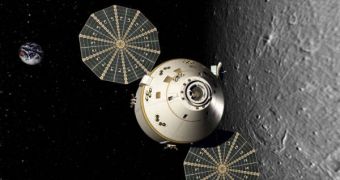The National Mall in Washington is currently the host of a more unusual exhibition. NASA has placed on display a mock-up of the future Orion capsule, the craft that is supposed to be the American space agency's main vehicle after 2015. Following the withdrawal of the shuttle fleet next year, the agency will be left without the ability to take humans to space, until the Orion is complete. The capsule can carry up to 6 astronauts, and NASA envisions using it to return to the Moon, to go to Mars, and even beyond. Orion is also part of the Constellation Project, together with the ARES rocket array.
“We're just very proud to build this, do some testing and demonstrate to America that we're moving beyond the space shuttle onto another generation of spacecraft,” Post-Landing Orion Recovery Test (PORT) Project Manager Don Pearson shared, as quoted by Reuters. Plans for the Orion are very ambitious, even NASA officials admit. The craft is to enter service around 2015, and will be used to ferry astronauts to and from the ISS at first, in six-month intervals.
One of the main reason for these “domestic flights” is that engineers will thus have the opportunity to check for any kinds of glitches or malfunctions that may constitute a serious threat during longer exploration missions. By 2020, the agency estimates that US astronauts will return to the Moon, with a trip to Mars and back envisioned to take place somewhere in the mid-2030s. While it is based on the design of the first lunar vehicles, the Apollo crafts, Orion is somewhat larger and able to house a crew of six, rather than just three astronauts. Its safety features are also naturally improved.
On April 6th, a full-scale simulation of a water landing will be performed, using the Orion mock-up, which is just as heavy as the functional prototype will be. The goal of the exercise is to analyze the acceleration and the tilt that astronauts forced to abort a launch sequence will be exposed to when hitting the waves. Later this year, space fliers will also begin to train in the capsule, practicing ways of getting out of it on rainy and stormy weather, and amidst large waves.

 14 DAY TRIAL //
14 DAY TRIAL //